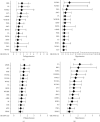Emergent Anthropometric Indices in Differential Prediction of Prehypertension and Hypertension in Mexican Population: Results according to Age and Sex
- PMID: 35844253
- PMCID: PMC9283069
- DOI: 10.1155/2022/4522493
Emergent Anthropometric Indices in Differential Prediction of Prehypertension and Hypertension in Mexican Population: Results according to Age and Sex
Abstract
Background: Hypertension (HTN) is recognized as a significant public health problem in the world. The objective of this study is to evaluate emergent anthropometric indices as predictors of preHTN and HTN according to age and sex in a sample of Mexican adults.
Methods: A cross-sectional study was conducted in 1,150 participants aged 18-80 years old. Anthropometric data and blood pressure measurements were analyzed. Comparisons between men and women were carried out by independent analysis. Cutoff points for each emergent anthropometric index were obtained using the values' upper second and third tertiles. Logistic regression models and receiver operating characteristics curve analyses were used to assess the association and the predictive value of several emergent anthropometric indices with the presence of preHTN and HTN.
Results: The prevalence of preHTN and HTN was 29.74% and 14.35%, respectively. In a logistic regression analysis adjusted by age and sex, the body roundness index (BRI) (OR = 2.08, p < 0.001) and conicity index (CI) (OR = 1.37, p=0.044) were associated with preHTN, while CI (OR = 2.47, p < 0.001) and waist to height squared (W/Ht2) (OR = 2.19, p < 0.001) were associated with HTN. Furthermore, in both sexes, BRI was the main predictor of preHTN (AUC: 0.634 and 0.656, respectively). Particularly, according to sex and age range, the predictive emergent anthropometric indices in men were the body shape index (ABSI) and waist to height cubic (W/Ht3) (AUC = 0.777 and 0.771, respectively), whereas in women, the predictors were CI and ABSI (AUC = 0.737 and 0.729, respectively). In men ≤40 years old, central body fat indices were predictors of preHTN and HTN, but in men >40 years old, the predictor indices were W/Ht3 and W/Ht2. In women ≤40 years, the pulse mass index (PMI) was the best main predictor (AUC = 0.909) of HTN.
Conclusion: CI, PMI, W/Ht3, W/Ht2, and ABSI could represent differential predictors of preHTN and HTN between men and women according to age range.
Copyright © 2022 Oscar Zaragoza-García et al.
Conflict of interest statement
The authors declare no conflicts of interest.
Figures

Similar articles
-
Predicting hypertension by obesity- and lipid-related indices in mid-aged and elderly Chinese: a nationwide cohort study from the China Health and Retirement Longitudinal Study.BMC Cardiovasc Disord. 2023 Apr 20;23(1):201. doi: 10.1186/s12872-023-03232-9. BMC Cardiovasc Disord. 2023. PMID: 37081416 Free PMC article.
-
[Different anthropometric indices and incident risk of hypertension in elderly population: a prospective cohort study].Zhonghua Yu Fang Yi Xue Za Zhi. 2019 Mar 6;53(3):272-278. doi: 10.3760/cma.j.issn.0253-9624.2019.03.007. Zhonghua Yu Fang Yi Xue Za Zhi. 2019. PMID: 30841666 Chinese.
-
Feasibility of body roundness index for identifying a clustering of cardiometabolic abnormalities compared to BMI, waist circumference and other anthropometric indices: the China Health and Nutrition Survey, 2008 to 2009.Medicine (Baltimore). 2016 Aug;95(34):e4642. doi: 10.1097/MD.0000000000004642. Medicine (Baltimore). 2016. PMID: 27559964 Free PMC article.
-
Anthropometric indices of obesity as predictors of high blood pressure among school children.Clin Exp Hypertens. 2022 Jan 2;44(1):11-19. doi: 10.1080/10641963.2021.1969662. Epub 2021 Oct 19. Clin Exp Hypertens. 2022. PMID: 34664528
-
Comparison of the ability to identify arterial stiffness between two new anthropometric indices and classical obesity indices in Chinese adults.Atherosclerosis. 2017 Aug;263:263-271. doi: 10.1016/j.atherosclerosis.2017.06.031. Epub 2017 Jun 16. Atherosclerosis. 2017. PMID: 28704699
Cited by
-
Body Composition Evaluation and Clinical Markers of Cardiometabolic Risk in Patients with Phenylketonuria.Nutrients. 2023 Dec 18;15(24):5133. doi: 10.3390/nu15245133. Nutrients. 2023. PMID: 38140392 Free PMC article. Review.
-
Body roundness index and the risk of hypertension: a prospective cohort study in Southwest China.BMC Public Health. 2024 Sep 18;24(1):2539. doi: 10.1186/s12889-024-20049-z. BMC Public Health. 2024. PMID: 39294669 Free PMC article.
References
-
- Guzmán-Guzmán I. P., Salgado-Goytia L., Muñoz-Valle J. F., Salgado-Bernabé A. B., Quiroz-Vargas I., Parra-Rojas I. Prehypertension in a Mexican population: influence of age, gender, and body fat. Clinical and Experimental Hypertension . 2013;35(1):67–73. doi: 10.3109/10641963.2012.690470. - DOI - PubMed
-
- Rivera-Mancía S., Colín-Ramírez E., Cartas-Rosado R., Infante O., Vargas-Barrón J., Vallejo M. Indicators of accumulated fat are stronger associated with prehypertension compared with indicators of circulating fat. Medicine (Baltimore) . 2018;97(34) doi: 10.1097/md.0000000000011869.e11869 - DOI - PMC - PubMed
LinkOut - more resources
Full Text Sources

